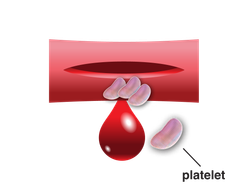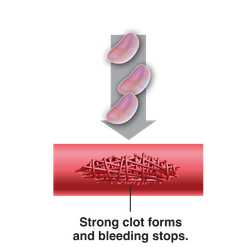In People with ITP, the Immune System Mistakenly Destroys Platelets that Are Needed for Blood Clotting
What is ITP?
- Idiopathic thrombocytopenic purpura (ITP) is a disorder in which blood does not clot properly.
- This happens because there aren’t enough platelets.
- Platelets are tiny cells that stick together to help make clots and stop bleeding.
- Without enough platelets, it takes longer than normal for blood to clot and bleeding to stop.
The Role of Platelets in Normal Blood Clotting



ITP may be easier to understand if you look at each word by itself:
- Immune—dealing with the system that protects the body from infection
- Thrombocytopenic—low numbers of platelets (also called thrombocytes) that are needed for blood clotting
- Purpura—bruises
Today, ITP is also known as primary immune thrombocytopenia.
What are the signs and symptoms of ITP?
The most common sign of ITP is bleeding. People with ITP may have:
- Purpura—purple bruises on skin or mucous membranes, like inside the mouth
- Petechiae—tiny red dots caused by minor bleeding under the skin; often looks like a rash
- Hematomas—clotted or partly clotted blood in an organ, tissue or body space. Hematomas can occur anywhere in the body, including the brain.
- Nosebleeds or bleeding from the gums
- Blood in the urine or stool
- Heavy menstrual bleeding (heavy periods) in women
- Any kind of bleeding that is hard to stop
- Fatigue or feeling of being tired
What causes ITP?
In most cases, ITP is caused by the immune system destroying the body’s platelets by mistake.
- ITP is a type of autoimmune disorder.
- An autoimmune disorder occurs when the body attacks itself.
- The cause of autoimmune disorders is not known.
Who gets ITP?
In children:
- ITP is usually a temporary condition that occurs rapidly, often after a viral infection.
- Most children with ITP recover without any treatment within 6 months.
In adults:
- ITP tends to be chronic (long-term) and is more common in women than in men.
- About 1 in every 4,000 adults has chronic ITP.
How is ITP treated?
- ITP cannot be cured, but it can be treated and managed.
- The goal of treatment is to raise blood platelet counts to a normal range.
-
One option for treatment is IVIg (intravenous immunoglobulin):
- Immunoglobulins (Ig) are part of the immune system.
- Treating people with ITP using Ig has been shown to raise platelet counts.
- Ig products are made by purifying blood plasma donated by people without ITP.

